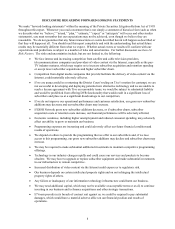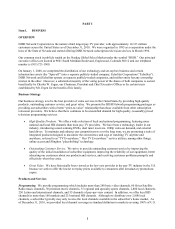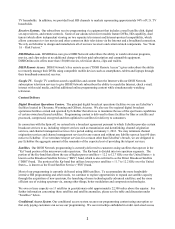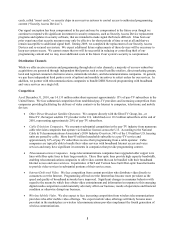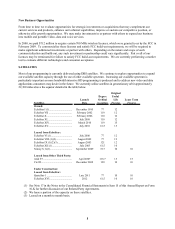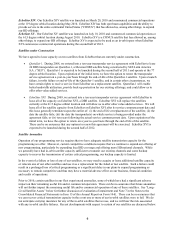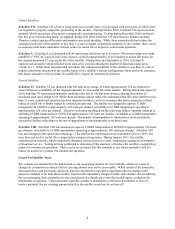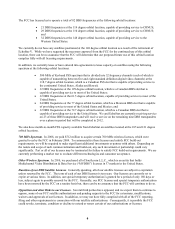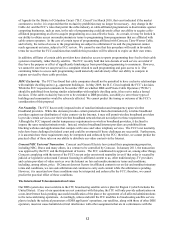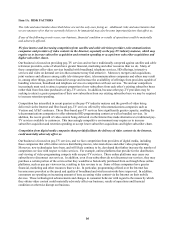Dish Network 2010 Annual Report Download - page 13
Download and view the complete annual report
Please find page 13 of the 2010 Dish Network annual report below. You can navigate through the pages in the report by either clicking on the pages listed below, or by using the keyword search tool below to find specific information within the annual report.
6
6
EchoStar XIV. Our EchoStar XIV satellite was launched on March 20, 2010 and commenced commercial operations
at the 119 degree orbital location during May 2010. EchoStar XIV has both spot beam capabilities and the ability to
provide service to the entire continental United States (“CONUS”) that has allowed us, among other things, to expand
our HD offerings.
EchoStar XV. Our EchoStar XV satellite was launched on July 10, 2010 and commenced commercial operations at
the 61.5 degree orbital location during August 2010. EchoStar XV is a CONUS satellite that has allowed us, among
other things, to expand our HD offerings. EchoStar XV is expected to be used as an in-orbit spare when EchoStar
XVI commences commercial operations during the second half of 2012.
Satellites under Construction
We have agreed to lease capacity on two satellites from EchoStar that are currently under construction.
• QuetzSat-1. During 2008, we entered into a ten-year transponder service agreement with EchoStar to lease
24 DBS transponders on QuetzSat-1, a Mexican DBS satellite being constructed by SES Latin America
S.A. (“SES”). QuetzSat-1 is expected to be launched during the second half of 2011 and operate at the 77
degree orbital location. Upon expiration of the initial term, we have the option to renew the transponder
service agreement on a year-to-year basis through the end-of-life of the QuetzSat-1 satellite. Upon a launch
failure, in-orbit failure or end-of-life of the QuetzSat-1 satellite, and in certain other circumstances, we
have certain rights to receive service from EchoStar on a replacement satellite. QuetzSat-1 will enable
better bandwidth utilization, provide back-up protection for our existing offerings, and could allow us to
offer other value-added services.
• EchoStar XVI. During 2009, we entered into a ten-year transponder service agreement with EchoStar to
lease all of the capacity on EchoStar XVI, a DBS satellite. EchoStar XVI will replace the satellites
currently at the 61.5 degree orbital location and will allow us to offer other value-added services. We will
lease all of the satellite capacity from EchoStar on EchoStar XVI after its service commencement date and
this lease generally terminates upon the earlier of: (i) the end of life or replacement of the satellite; (ii) the
date the satellite fails; (iii) the date the transponder(s) on which service is being provided under the
agreement fails; or (iv) ten years following the actual service commencement date. Upon expiration of the
initial term, we have the option to renew on a year-to-year basis through the end of life of the satellite.
There can be no assurance that any options to renew this agreement will be exercised. EchoStar XVI is
expected to be launched during the second half of 2012.
Satellite Anomalies
Operation of our programming service requires that we have adequate satellite transmission capacity for the
programming we offer. Moreover, current competitive conditions require that we continue to expand our offering of
new programming, particularly by expanding local HD coverage and offering more HD national channels. While
we generally have had in-orbit satellite capacity sufficient to transmit our existing channels and some backup
capacity to recover the transmission of certain critical programming, our backup capacity is limited.
In the event of a failure or loss of any of our satellites, we may need to acquire or lease additional satellite capacity
or relocate one of our other satellites and use it as a replacement for the failed or lost satellite. Such a failure could
result in a prolonged loss of critical programming or a significant delay in our plans to expand programming as
necessary to remain competitive and thus may have a material adverse effect on our business, financial condition
and results of operations.
Prior to 2010, certain satellites in our fleet experienced anomalies, some of which have had a significant adverse
impact on their remaining useful life and/or commercial operation. There can be no assurance that future anomalies
will not further impact the remaining useful life and/or commercial operation of any of these satellites. See “Long-
Lived Satellite Assets” below for further discussion of evaluation of impairment and Note 7 in the Notes to the
Consolidated Financial Statements in Item 15 of this Annual Report on Form 10-K. There can be no assurance that
we can recover critical transmission capacity in the event one or more of our in-orbit satellites were to fail. We do
not anticipate carrying insurance for any of the in-orbit satellites that we use, and we will bear the risk associated
with any in-orbit satellite failures. Recent developments with respect to certain of our satellites are discussed below.




